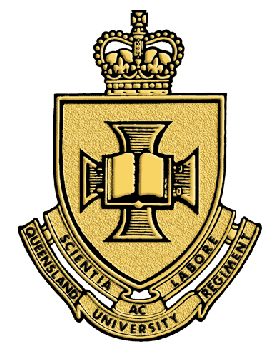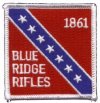University of North Georgia drill team
In 1950, a drill platoon was formed for use in Spring parades at the University of North Georgia. The team was named the Honor Platoon. The name was later changed to the Drill Platoon. In 1965, the Drill Platoon was renamed the Blue Ridge Rifles in honor of the Dahlonega volunteer unit. [3]
Since its early beginnings, the Blue Ridge Rifles Drill Team has earned state and national recognition. In 1967 the unit placed second in the Vanderbilt Invitational Drill Competition. [3] Their earliest first-place victory came in 1971 at the East Tennessee State University Drill Meet in Tennessee, and have since won First Place honors at the nationally recognized Mardi Gras Invitational Drill Meet in New Orleans, Louisiana, hosted by Tulane University.
The Blue Ridge Rifles won their first national championship for precision drill teams at Eastern Kentucky University (EKU) in 1982, while commanded by cadet CPT Harden Hopper, with Drill Master cadet MSG Lewis Lockett. The faculty advisor was MAJ Charles Clarkson. EKU was an invitational drill meet that included the Pershing Rifle national championship as a sub-element. The Blue Ridge Rifles took first place overall, beating all teams competing, to include the Pershing Rifle champion team from St. Peters College, commanded by cadet CPT George Santana. Also in 1982, the Blue Ridge Rifles took first place at the Mardi Gras invitational drill meet at Tulane and first place at the Georgia Tech invitational. The 1981-82 unit has been heralded as the greatest Blue Ridge Rifles team in school history, as it won first-place overall in all the meets entered that year.
Overall the Blue Ridge Rifles have won 16 out of 24 Mardi Gras Appearances. In 1983 the Blue Ridge Rifles, commanded by cadet CPT D. Lee Hackle, with Executive Officer cadet 1LT Jerry Purvis and Drill Master cadet MSG Ken Marshall, again won the national title at Bowling Green University in Ohio.
Sergeant is a rank in use by the armed forces of many countries. It is also a police rank in some police services. The alternative spelling, serjeant, is used in The Rifles and other units that draw their heritage from the British light infantry. Its origin is the Latin serviens, 'one who serves', through the Old French term serjant.

The Texas A&M University Corps of Cadets is a student military organization at Texas A&M University. Established with the university in 1876, it is the oldest student organization on campus.

A section is a military sub-subunit. It usually consists of between 6 and 20 personnel. NATO and U.S. doctrine define a section as an organization "larger than a squad, but smaller than a platoon." As such, two or more sections usually make up an army platoon or an air force flight.

A drill team can be one of four different entities:
- A military drill team is a marching unit that performs routines based on military foot or exhibition drills. Military drill teams perform either armed or unarmed.
- A dance drill team creates routines based on precision dance movements rather than military drill. These teams usually do not carry anything, but may use props in field production numbers. They may perform to recorded music, or the live music of an accompanying marching band.
- A team that execute routines carrying either one or multiple flags or pom-poms. This team's movements are also based in dance and may also have a heavy influence of gymnastics as well. These teams also may perform to music, either live or recorded.
- A team that is mounted or advances some type of mobile object. May also include teams of dogs and handlers.

The Virginia Tech Corps of Cadets (VTCC) is the military component of the student body at Virginia Polytechnic Institute and State University. Cadets live together in residence halls, attend morning formation, wear a distinctive uniform, and receive an intensive military and leadership educational experience similar to that available at the United States service academies. The Corps of Cadets has existed from the founding of the Virginia Agricultural and Mechanical College in 1872 to the present-day institution of Virginia Tech, which is designated a senior military college by federal law. As of August 2021, about 1,200 cadets are currently enrolled in the program.

Exhibition drill is a variant of drill that involves complex marching sequences which usually deviate from drill used in the course of ordinary parades. Teams performing exhibition drill are often affiliated with military units, but the scope of exhibition drill is not limited to military drill teams. Exhibition drill is often performed by Armed Forces Precision Drill Teams, the drill teams at service academies and ROTC and JROTC units, and civilian drill teams that perform at parades, drill meets, and half-time shows and other public venues.

The National Society of Pershing Rifles is a military-oriented honor society for college-level students founded in 1894 as a drill unit at the University of Nebraska–Lincoln. It is the oldest continuously operating US college organization dedicated to military drill. Originally named Varsity Rifles, members renamed the organization in honor of their mentor and patron, Lieutenant John J. Pershing, upon his departure from the university in 1895.

Norwich University – The Military College of Vermont is a private senior military college in Northfield, Vermont. It is the oldest private and senior military college in the United States and offers bachelor's and master's degrees on-campus and online. The university was founded in 1819 in Norwich, Vermont, as the American Literary, Scientific and Military Academy. It is the oldest of six senior military colleges and is recognized by the United States Department of Defense as the "Birthplace of ROTC".

Queensland University Regiment (QUR) is a training unit of the Australian Army Reserve. Based in Queensland, the regiment is currently assigned to the 8th Brigade. The regiment's history can be traced back to 1932 when the University Rifles was formed. During World War II, the regiment's predecessor unit did not serve overseas, but many of its personnel were deployed as part of the 7th Brigade or within units of the Second Australian Imperial Force. After the war, the regiment was formed under its current designation. Since then, its size has fluctuated as its role has changed. Currently, it is responsible for providing training for Reserve officer cadets, officers and soldiers.

The Summerall Guards are a military drill platoon at The Citadel, a military college in Charleston, South Carolina. The Summerall Guards were formed in 1932 and are named after General Charles P. Summerall, former chief of staff of the United States Army and president of The Citadel from 1931 to 1953.

The California Cadet Corps (CACC), originally called the California High School Cadets, is a component of the California Youth and Community Programs Task, Task Force Torch. The California Cadet Corps is a paramilitary youth organization in California open to students in the college, high school, middle school and elementary school grades.

A drill purpose rifle is a rifle which has been altered so that it can no longer be fired. This is generally undertaken by either removing the firing pin or leading the barrel. These rifles are used solely for drill purposes, training and teaching, usually by cadet forces. These rifles can be marched with and can also be used to perform exhibition style individual or group maneuvers.

Southern Preparatory Academy is a private military school located in Camp Hill, Alabama for boys in grades 6-12.

The Tulane University Marching Band (TUMB) is the marching band of Tulane University. It performs at every Tulane Green Wave football home game in Yulman Stadium, bowl games, and some away games. It is also marches in New Orleans Mardi Gras parades each year, having appeared in Le Krewe d'Etat, the Krewe of Thoth, the Krewe of Bacchus, and the Krewe of Rex, among others.
The Coed Affiliates Pershing Rifles (CAPER) was established in 1966 as the first officially recognized female auxiliary to the National Society of Pershing Rifles. It was disbanded in the early 1980s when women were fully integrated into Pershing Rifles. The organization has also been called the Coed Affiliates of Pershing Rifles and CAPERS over the years.

The University of North Georgia (UNG) is a public senior military college with multiple campuses in Georgia. It is part of the University System of Georgia. The university was established on January 8, 2013, by a merger of North Georgia College & State University and Gainesville State College. Campus locations include Dahlonega, Oakwood, Watkinsville, Blue Ridge, and Cumming.

The Army Reserve Officer Training Corps (AROTC) is the United States Army component of the Reserve Officers' Training Corps. It is the largest Reserve Officer Training Corps (ROTC) program which is a group of college and university-based officer training programs for training commissioned officers for the United States Army and its reserves components: the Army Reserves and the Army National Guard. There are over 30,000 Army ROTC cadets enrolled in 274 ROTC programs at major universities throughout the United States. These schools are categorized as Military Colleges (MC), Military Junior Colleges (MJC) and Civilian Colleges (CC).
The National Society of Blackjacks is a High School Junior Reserve Officer Training Corps leadership program based on the example of General of the Armies John J. Pershing. The Blackjacks are the high school auxiliary of the National Society of Pershing Rifles.

The Gator Guard Drill Team, abbreviated GGDT, is a precision drill team and military fraternity based at the University of Florida (UF). The team is named after the Florida Gator, the mascot of the UF. Founded in 1953, the Gator Guard is most widely known for its annual performances in the New Orleans Mardi Gras Parades. In 2016, the team consisted of 31 active male and female members. And would frequently chant, "Go Gators!"

Oregon State University Army ROTC is an ROTC Battalion assigned to Oregon State University in Corvallis, Oregon. Its mission is to train Cadets in basic military leadership and commission them as 2nd Lieutenants upon the completion of a bachelor's degree. Founded in 1873, the ROTC Battalion has continued to serve the nation and US Army Cadet Command and was given the nickname, "The West Point of the West" after it produced more commissioned officers than any other ROTC Battalion in the USA during World War II.


















